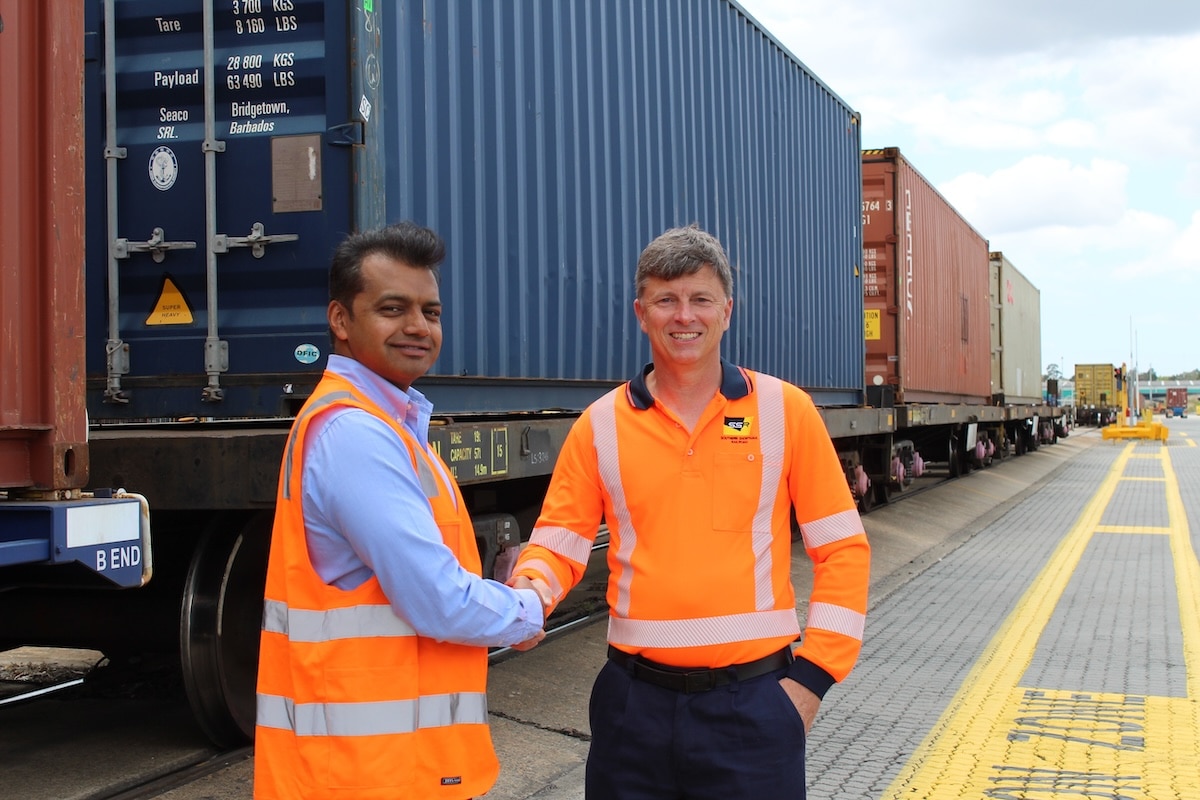In a positive development for both the Victorian and national supply chains, the Intermodal Terminal Company (ITC) and above-rail freight operator Southern Shorthaul Railroad (SSR) have entered into an agreement for the future delivery of haulage services to/from the $400 million Somerton Intermodal Terminal, in Melbourne’s north.
ITC CEO Mishkel Maharaj spoke about the announcement.
“ITC is delighted to have entered into an agreement with highly respected and experienced rail freight operator SSR for the provision of interstate, regional and port shuttle haulage services at the future open access intermodal terminal in Somerton,” he said.
“Over the past two decades, SSR has developed a strong reputation with customers in the intermodal and bulk freight sectors for safe, cost-efficient and reliable above-rail haulage operations.
“With 65 per cent of construction of the $400 million freight terminal now complete, rail haulage operations and logistics services are due to commence at Somerton in late 2025. The future open access intermodal terminal will enable customers in the north to efficiently utilise rail freight shuttle operations to and from the Port of Melbourne, not to mention allowing future customers to access interstate and regional services.”
The Western/Metropolitan Ring Road (M80) and new North East Link will allow customers in Melbourne’s west and south-east to efficiently access the future intermodal terminal at Somerton, thereby helping to reduce traffic congestion and vehicle emissions on inner Melbourne roads.
“Not only does the future open access intermodal terminal at Somerton feature more than 30-hectares of terminal hardstands and nine rail sidings to facilitate both interstate and import/export operations, but it will also provide customers with on-site facilities to wash, repair and fumigate shipping containers,” Maharaj said.
“The sheer size and scale of the future intermodal terminal at Somerton will allow the efficient and cost-effective decoupling and loading/unloading of 600-metre port shuttle services and 1,500- and 1,800-metre interstate freight trains.”
The future intermodal terminal at Somerton provides customers in the supply chain with the ‘best of both worlds’ – direct access to ARTC’s vast 7,500-kilometre standard-gauge interstate network and Victoria’s standard- and broad-gauge metropolitan (including the dual-gauge Port Rail Shuttle Network) and regional branch lines.
By rail, the future intermodal terminal located in the northern suburbs of Melbourne at Somerton is only 22.5-kilometres from Australia’s largest container and general cargo port, the Port of Melbourne.
Initial capacity of the future ITC open access intermodal terminal at Somerton will be approximately one million 20-foot equivalent units (TEUs) – containers – each year.
SSR Owner Jason Ferguson said SSR is excited to be involved in such a critical piece of productive rail freight infrastructure for both the Victorian and national supply chains.
“I’m delighted a 100 per cent Australian-owned and operated rail freight operator like SSR can partner with a company like ITC which is backed by one of Australia’s largest superannuation companies – Aware Super,” he said.
“Over the past 20 years, SSR has grown into an above-rail operator which now operates more than 110 freight locomotives and 1,300 container and bulk wagons to deliver approximately 170 weekly rail services for customers in interstate and regional supply chains.
“I’m proud to say SSR has developed a strong reputation in the sector for providing unrivalled technical rail freight expertise and experience in delivering end-to-end haulage solutions for customers in the supply chain,” he said.
Maharaj said that in addition to the $400 million intermodal development, Aware Real Estate in partnership with Barings also recently invested $600 million to acquire a large existing industrial precinct at Somerton in the heart of Melbourne’s busy northern freight catchment zone.
“A billion dollars has now been privately invested to deliver a fully integrated large-scale freight and logistics precinct in Somerton, with supply chain customers having the benefit of being able to access interstate, regional and port shuttle rail freight services at one central location,” he said.
“Future customers of the Somerton industrial precinct will be able to co-locate warehousing and related logistics services, thereby enhancing their overall cost-eOiciency in supply chain operations.
“The future intermodal terminal at Somerton will also feature electric-powered freight handling machinery and equipment, including rail mounted gantry cranes and reach stackers, which will help customers reduce their carbon footprint in supply chain operations and services,” he said.
In yet another boost for future customers of the ITC intermodal terminal at Somerton it will be a customs-bonded facility.
Maharaj said future ITC customers will note that within a seven-kilometre radius of the future intermodal terminal at Somerton is approximately three million square metres of warehousing capacity.
“Another key feature of the future intermodal terminal at Somerton will be several empty container parks totaling approximately 10-hectares in size,” he said.
At the future intermodal in Somerton, ITC customers will enjoy access to a state-of-the-art intermodal terminal both in terms of operational and emissions reduction technology.
ITC aims to build a national portfolio of open-access interstate intermodal and import/export terminals featuring world-class safety, freight handling services, and emissions-reducing equipment and technologies at no cost to the Australian taxpayer.
The post Intermodal terminal owner teams up with interstate and regional rail freight operator appeared first on Rail Express.




Great news for the rail industry but I have a question how will it work where does the traffic into the yard originate?
The yard is being rebuilt is the word. I can’t see why SH would be needed when the containers are only going between there and the docks.
1 million is a lot of containers. How many trains per day?
Most trains in Melbourne metro area do not exceed 40 wagons IIRC. If you consider and assume all those 1,000,000 20 foot TEU head to the port then that is 25,000 trains per year. Lets say they managed to run 80 wagon shuttles to the port, not sure if this is possible, it would be 12,500 trains per year over 52 weeks of service equates to 240 trains per week.
That still makes no sense.